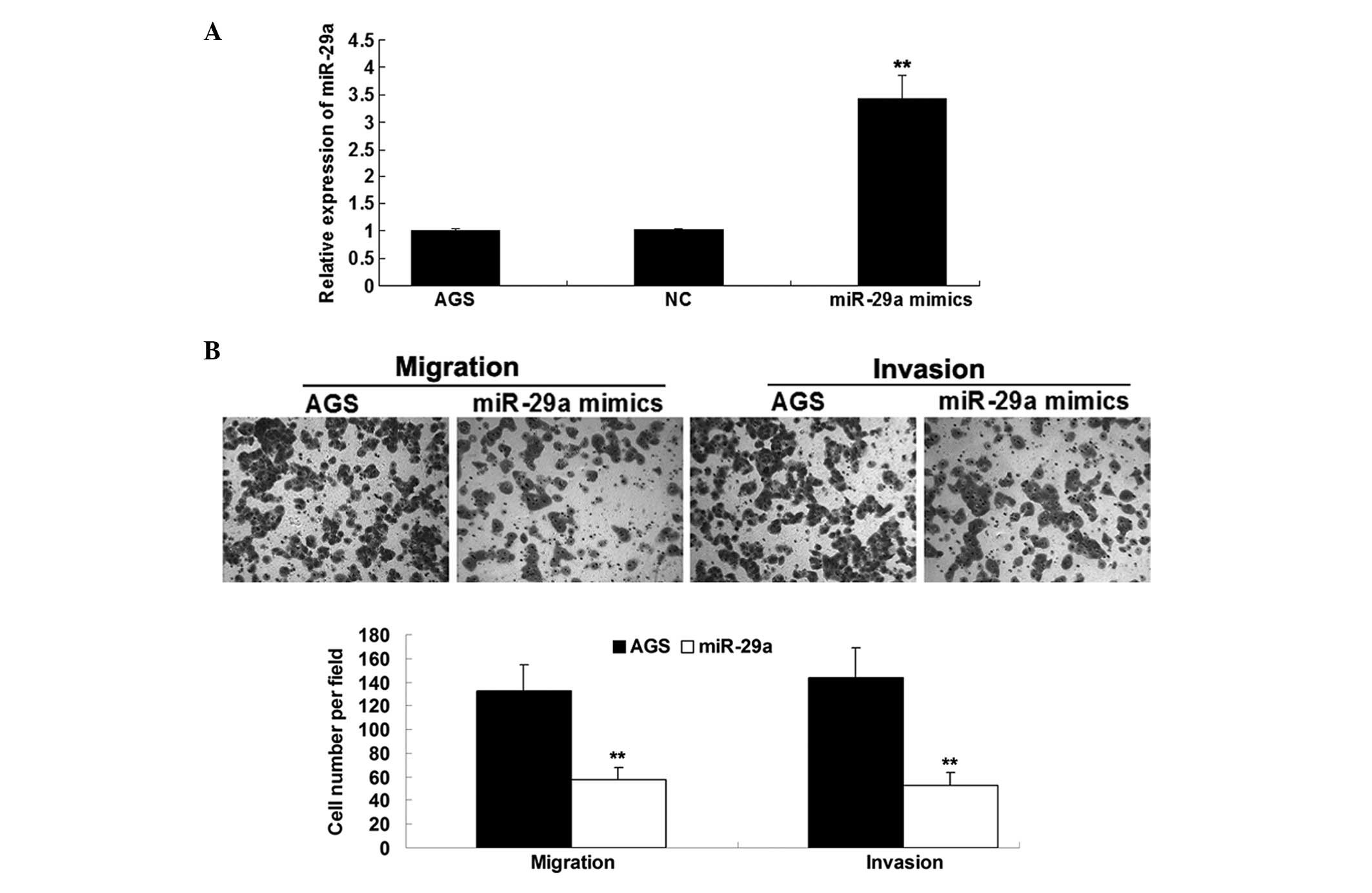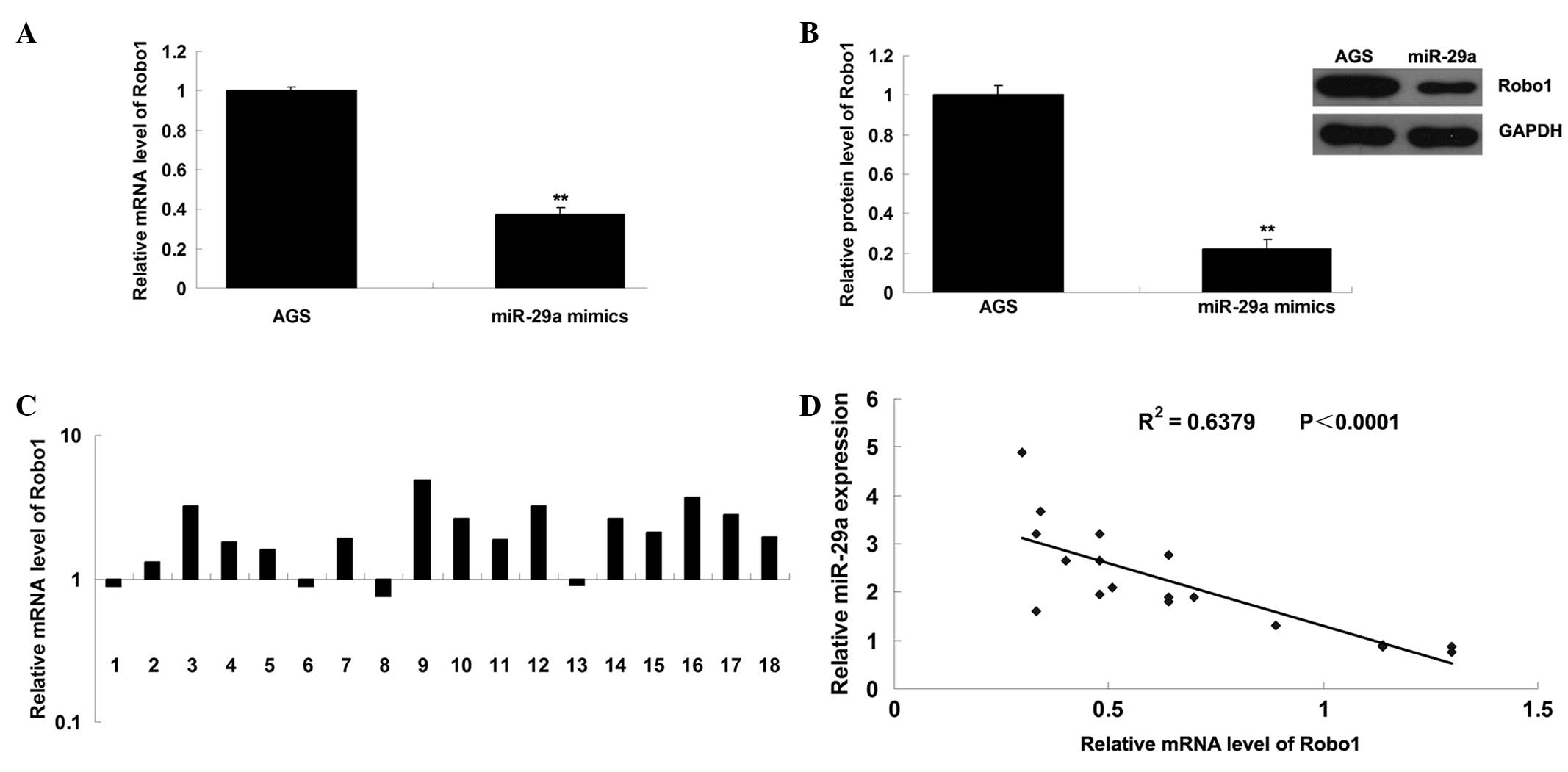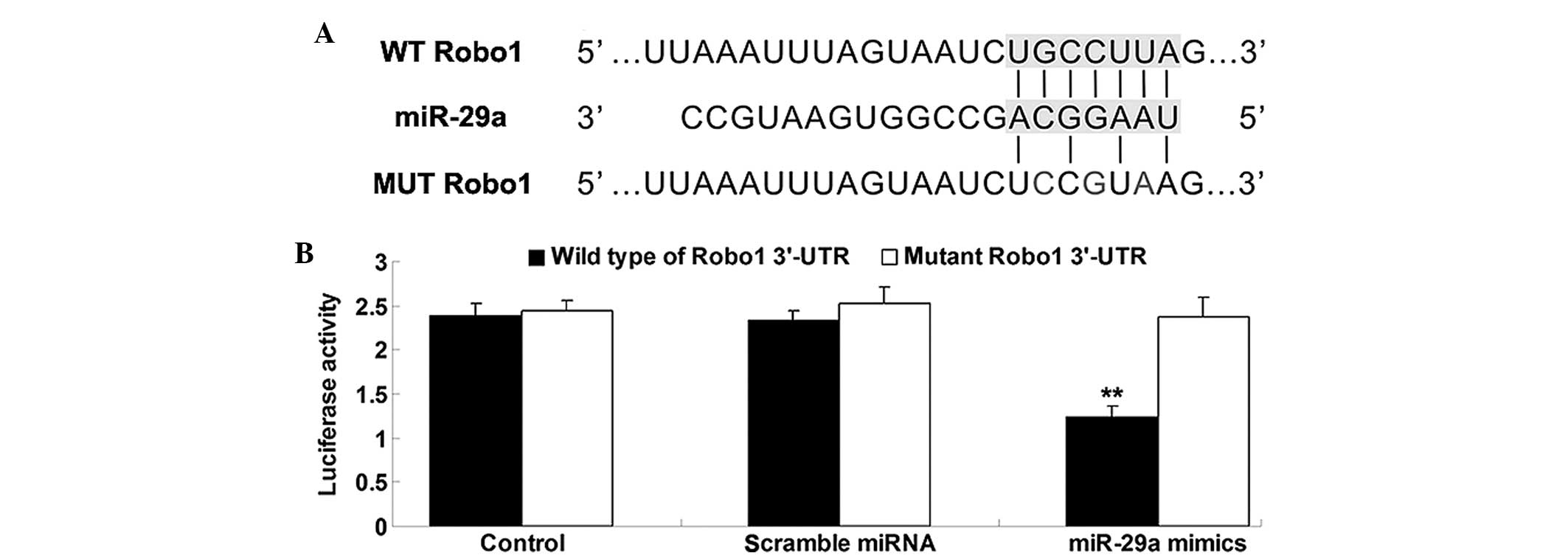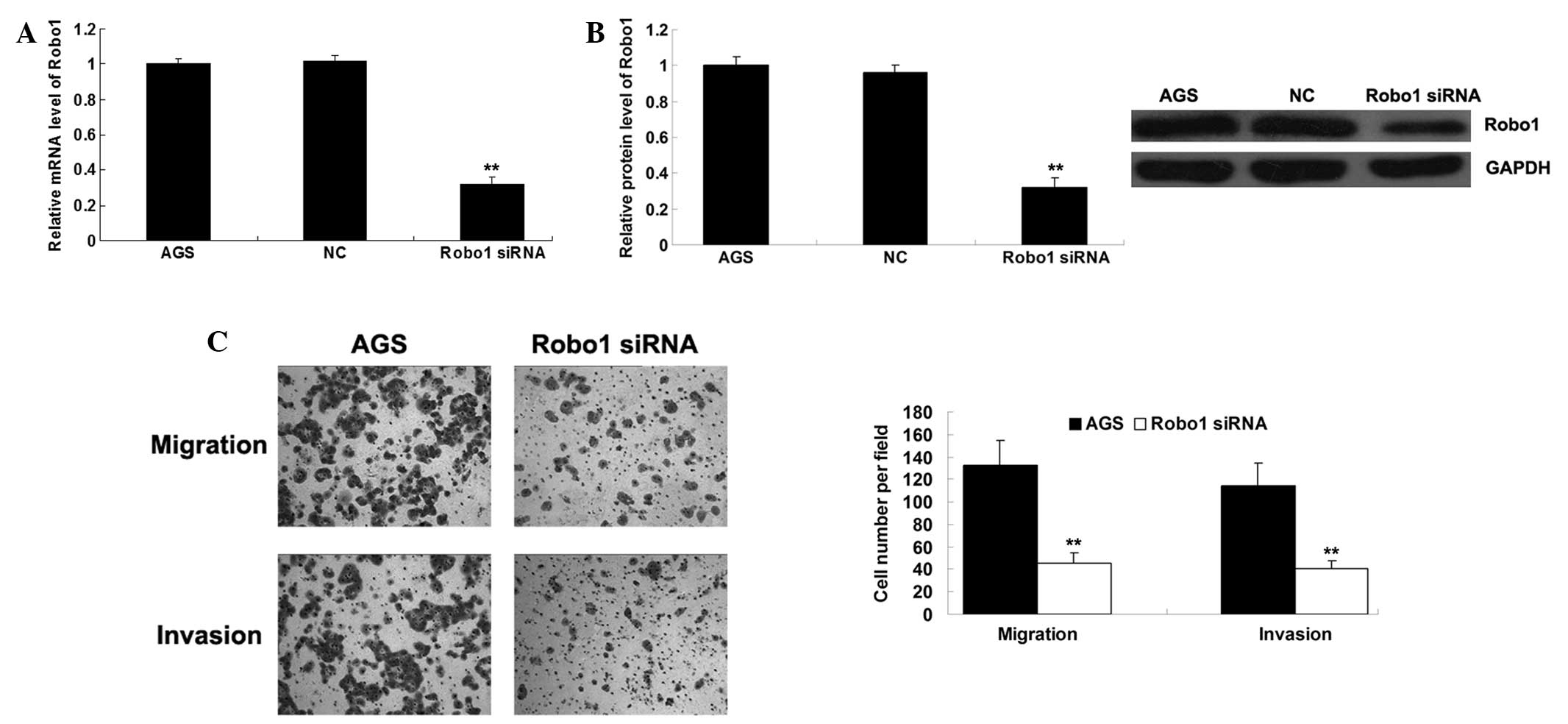MicroRNA-29a inhibits cell migration and invasion via targeting Roundabout homolog 1 in gastric cancer cells
- Authors:
- Published online on: May 22, 2015 https://doi.org/10.3892/mmr.2015.3817
- Pages: 3944-3950
Abstract
Introduction
Gastric cancer is one of the most prevalent types of human cancer, and is the second most common cause of cancer-associated mortality (1). Previously, surgical resection combined with chemotherapy has helped save the lives of patients with gastric cancer at an early stage (2,3). However, the prognosis of patients with gastric cancer at a late stage remains poor, predominantly due to metastasis and recurrence (2,3). Therefore, studies into effective molecular targets for gastric cancer metastasis are necessary and important.
Roundabout homolog 1 (Robo1), a member of the Robo family, has been observed to be expressed in various types of cells. It has been reported that Robo1 acts as a critical regulator in multiple biological processes, including proliferation, differentiation and migration (4,5). Robo1 has mononucleotide repeats in the coding exons, which may be mutation targets in cases of cancer with microsatellite instability (6). Je et al (7) reported five frameshift mutations in the repeats, and co-occurrences of mutation and loss of expression of the Robo1 gene were also observed in gastric cancer tissues, suggesting that Robo1 may serve an important role in gastric cancer. In addition, the protein expression levels of Robo1 were observed to be negatively regulated by microRNA (miR)-218, and miR-218 was able to inhibit invasion and metastasis of gastric cancer by inhibiting Robo1, indicating that Robo1 is associated with the invasion and metastasis of gastric cancer (7). It has been well established that one gene can be targeted by numerous miRs and that one miR has various target genes (8). Accordingly, additional miRs targeting Robo1 may also exist in gastric cancer, and serve crucial roles in the regulation of migration and invasion in gastric cancer cells.
Previously, deregulation of miR-29a has been demonstrated to participate in the initiation and development of several types of human cancer, including neuroblastoma, glioma, breast cancer and gastric cancer (9–12). Chen et al (11) revealed that miR-29a had an inhibitory effect on growth and invasion of gastric cancer cells via targeting vascular endothelial growth factor A (VEGF-A), suggesting that miR-29a acts as a tumor suppressor in gastric cancer. However, whether there is an association between miR-29a and Robo1 in gastric cancer remains to be fully elucidated.
In the current study, the expression levels of Robo1 and miR-29a were investigated in gastric cancer tissues and cell lines. Subsequently, the roles of Robo1 and miR-29a in migration and invasion of the AGS and SGC-7901 gastric cancer cell lines were further investigated.
Materials and methods
Clinical tissue collection
Written informed consent was collected from all patients with gastric cancer and the present study was approved by the ethics committee of The First Affiliated Hospital of Anhui Medical University (Hefei, China). The patients were aged between 43 and 68 and included 10 males and 7 females. The samples were collected between June and October 2012 by tumor resection. A total of 17 gastric cancer tissues and their matched adjacent normal tissues were obtained from the Department of General Surgery, The First Affiliated Hospital of Anhui Medical University (Hefei, China).
Cell culture
Human AGS and SGC-7901 gastric cancer cells, in addition to the human normal GES-1 gastric mucosal epithelial cell line were obtained from the Cell Bank of Central South University (Changsha, China). Cells were cultured in Dulbecco's modified Eagle's medium (DMEM; Invitrogen Life Technologies, Carlsbad, CA, USA) supplemented with 10% fetal bovine serum (FBS; Invitrogen Life Technologies), 100 IU/ml penicillin (Sigma-Aldrich, St. Louis, MO, USA) and 100 µg/ml streptomycin sulfate (Sigma-Aldrich) at 37°C with 5% CO2.
Transient transfection
The Robo1 small interfering RNA (siRNA), Robo1 plasmid, miR-29a mimic, miR-29a inhibitor and scramble miRNA were purchased from Nlunbio (Changsha, China). Cells in the logarithmic growth phase were seeded into 6-well plates. Transfection of cells with these oligonucleotides was performed using Lipofectamine 2000 (Life Technologies, Carlsbad, CA, USA) according to the manufacturer's instructions.
Reverse transcription-quantitative polymerase chain reaction (RT-qPCR)
Total RNA was extracted from cells with TRIzol reagent (Life Technologies) according to the manufacturer's instructions. The relative expression of miR-29a was determined by RT-qPCR using the mirVana™ qRT-PCR microRNA Detection kit (Life Technologies) following the manufacturer's instructions. Specific primer sets for miR-29a and U6 (internal reference) were obtained from Life Technologies. Expression of Robo1 mRNA was determined by RT-qPCR using the standard SYBR Green RT-PCR kit (Takara Bio, Inc., Otsu, Japan) following the manufacturer's instructions. The specific primer pairs used were as follows: Robo1, sense 5′-CTTACACCCGTAAAAGTGACGC-3′ and antisense 5′-TGGTCTCTCTAAGACAGTCAGC-3′; GAPDH as an internal control, sense 5′-CTGGGCTACACTGAGCACC-3′ and antisense 5′-AAGTGGTCGTTGAGGGCAATG-3′. The following cycling conditions were used: 95°C for 10 min and 40 cycles of denaturation at 95°C for 15 sec and an annealing/elongation step at 60°C for 60 sec. Reverse transcription was performed at 16°C for 30 min, followed by an incubation step at 42°C for 30 min and enzyme inactivation at 85°C for 5 min. An ABI 7500 Fast Real-Time PCR System (Applied Biosystems, Foster City, CA, USA) was used. The relative expression of Robo1 mRNA or miR-29a was quantified using GraphPad Prism software, version 4.0 (GraphPad Software, Inc., La Jolla, CA, USA) and the 2−ΔΔCt method.
Cell migration and invasion assays
Cell migration and invasive capabilities were determined by performing a Transwell assay (Chemicon International, Inc., Temecula, CA, USA). For the migration assay, cells were plated in the upper chamber with the non-coated membrane. For the invasion assay, the chamber was coated with Matrigel (Becton Dickinson, Franklin Lakes, NJ, USA) and dried overnight, then cells were plated in the upper chamber with the Matrigel-coated membrane. For the two assays, DMEM supplemented with 10% FBS was used as a chemoattractant in the lower chamber. Following 24 h of incubation at 37°C, cells on the lower face of the membrane were stained with 0.4% crystal violet for 20 min and observed under a microscope (CX22; Olympus, Tokyo, Japan).
Western blotting
Total protein was extracted using radioimmunoprecipitation assay solution (Sigma-Aldrich). The protein concentration was determined by the Bradford DC protein assay (Bio-Rad Laboratories, Inc., Hercules, CA, USA). For determination of the protein level, proteins were separated with 10% SDS-PAGE and were blotted onto polyvinylidene difluoride (PVDF; Invitrogen Life Technologies) membranes, which were then incubated in Tris-buffered saline with Tween-20 (Sigma-Aldrich) with 50 g/l skimmed milk at room temperature for 4 h. Subsequently, the PVDF membranes were incubated with mouse anti-Robo1 (cat. no. ab201632; 1:50 dilution; Abcam, Cambridge, MA, USA) and mouse anti-GAPDH antibodies (cat. no. sc-365062; 1:50 dilution; Santa Cruz Biotechnology, Inc., Dallas, TX, USA), respectively, at room temperature for 1 h. Following washing with PBST three times, the PVDF membranes were incubated with peroxidase-conjugated rabbit anti-mouse secondary antibody (cat. no. ab175743; 1:20,000 dilution; Abcam) for 1 h at room temperature. Chemiluminescent detection was performed with an ECL kit (Pierce Chemical Company, Rockford, IL, USA).
Bioinformatical analysis
TargetScan (Release 6.2, www.targetscan.org) was used to predict the putative target genes of miR-29a.
Dual luciferase reporter assay
SGC-7901 cells were cotransfected using Lipofectamine 2000 with the reporter constructs Robo1-3′ untranslated region (UTR)-psi-CHECK2 (containing the 3′-UTR of Robo1 including the miRNA-29a binding sites) or mutant-Robo1-3′UTR-psi-CHECK2 (containing the corresponding mutated sequence of 3′-UTR of Robo1), while miR-29a mimics or scramble miRNA were used as the negative control. Luciferase activity was determined after 48 h using the Dual-Glo Substrate system (Promega Corporation, Madison, WI, USA) and the LD400 Luminometer (Beckman Coulter, Inc., Brea, CA, USA). Data are presented as the ratio of Renilla luciferase to Firefly luciferase.
Statistical analysis
Data are expressed as the mean ± standard deviation. Differences between two groups were determined using Student's t-test. Analysis was performed using SPSS software, version 15.0 (SPSS, Inc., Chicago, IL, USA). P<0.05 was considered to indicate a statistically significant difference.
Results
Expression of miR-29a is downregulated in gastric cancer tissues and cell lines
The endogenous expression of miR-29a was determined in human gastric cancer tissues and their adjacent normal tissues using RT-qPCR. As demonstrated in Fig. 1A, the relative expression of miR-29a was frequently downregulated in 77.8% (14/18) of gastric cancer tissues compared with the corresponding adjacent normal tissues. Similarly, it was identified that expression of miR-29a was significantly reduced in AGS and SGC-7901 gastric cancer cell lines, compared with that of the GES-1 human gastric mucosal epithelial cell line (Fig. 1B). It is suggested that downregulation of miR-29a may be associated with the development and progression of gastric cancer.
Overexpression of miR-29a inhibits the migration and invasion of gastric cancer cell lines
Based on the results obtained, whether miR-29a serves a role in the regulation of migration and invasion of gastric cancer cells was further investigated. AGS human gastric cancer cells were transfected with miR-29a mimics or the negative control, respectively. As indicated in Fig. 2A, transfection of miR-29a mimics resulted in a significant increase in miR-29a expression, when compared with the negative control transfected with scramble miRNA. In addition, it was further identified that restoration of miR-29a led to reduced migration and invasion of gastric cancer cells, when compared with the control cells (Fig. 2B). Accordingly, it is suggested that miR-29a acts as a tumor suppressor and contributes to inhibition of migration and invasion of gastric cancer cells.
miR-29a negatively regulates Robo1 gene expression
Targetscan prediction software was further used to identify potential targets for miR-29a. Robo1 was identified as a putative target gene for miR-29a, which has been reported to participate in the regulation of cell migration and invasion (13). To further confirm this prediction, the mRNA and protein expression levels of Robo1 were determined in AGS cells transfected with miR-29a mimic. It was observed that the mRNA and protein expression of Robo1 was significantly downregulated following overexpression of miR-29a, compared with the negative control (Fig. 3A and B). Furthermore, the mRNA levels of Robo1 in gastric cancer and adjacent normal tissues were determined with RT-qPCR, then the significance of the miR-29a/Robo1 correlation was assessed in gastric cancer. As presented in Fig. 3C, the mRNA expression of Robo1 was frequently increased in gastric cancer tissues, compared with the matched adjacent normal tissues. Furthermore, as demonstrated in Fig. 3D, a significant inverse correlation was observed between miR-29a and Robo1 mRNA expression. Accordingly, the data suggest that miR-29a negatively regulates Robo1 gene expression and Robo1 is a potential target gene of miR-29a.
Robo1 3′-UTR is a target of miR-29a
To verify whether Robo1 3′-UTR is a target of miR-29a, a luciferase reporter assay was conducted. The vectors containing the wide type of Robo1 3′UTR as well as the mutant type of Robo1 3′UTR were constructed (Fig. 4A). As demonstrated in Fig. 4B, cotransfection of AGS cells with Robo1-3′-UTR/pmirGLO and miR-29a mimics resulted in a significant reduction in the luciferase activity, when compared with the negative control (P<0.05). This inhibitory effect was abrogated by point mutations in the core binding sites of the Robo1 3′-UTR. All of these observations indicated that miR-29a exerts suppressive effects on Robo1 expression via binding to the 3′ UTR of Robo1.
Knockdown of Robo1 reduces migration and invasion in gastric cancer cells
To verify the effect of Robo1 on gastric cancer cell migration and invasion, the expression of Robo1 was observed to be downregulated by Robo1 siRNA. As presented in Fig. 5A and B, the mRNA and protein expression levels of Robo1 were notably downregulated following knockdown of the Robo1 gene in AGS cells. Consistently, downregulation of Robo1 markedly inhibited migration and invasion in AGS cells (Fig. 5C), which resembled the suppressive effects of miR-29a. These observations suggest that miR-29a may inhibit gastric cancer cell migration and invasion via targeting Robo1.
Discussion
Initiation and progression of cancer has been demonstrated to involve deregulation of various genes, including upregulation of oncogenes and downregulation of tumor suppressor genes (14). Robo1 has been reported to be involved in gastric cancer. Tie et al (7) demonstrated that as a target of miR-218, Robo1 contributed to gastric cancer metastasis (7). In addition, dysfunction of miR-29a has been reported to be involved in gastric cancer (11). However, the downstream target gene of miR-29a in gastric cancer remains largely unclear. In the current study, it was observed that miR-29a/Robo1 signaling serves a key role in the regulation of migration and invasion in gastric cancer cells. The expression levels of miR-29a were frequently reduced in gastric cancer tissues, when compared with matched adjacent normal tissues. Furthermore, miR-29a was additionally downregulated in gastric cancer cell lines compared with the normal gastric mucosal epithelial cell line. These observations suggest that miR-29a may serve a role in the malignant progression of gastric cancer. It was further demonstrated that restoration of miR-29a and knockdown of Robo1 may significantly inhibit the migratory and invasive capabilities of gastric cancer cells, and Robo1 was identified as a novel target of miR-29a. These observations suggest that Robo1 may act as an oncogene while miR-29a is hypothesized to be a tumor suppressor in gastric cancer. Thus, it is suggested that their deregulation may promote gastric cancer metastasis.
It is widely accepted that deregulated expression levels of certain miRNAs directly participate in the development and progression of numerous types of human cancer. In addition to its role in cancer, miR-29a has also been demonstrated to be associated with osteoblastic differentiation (15), myogenesis (16), sclerosis (17), fibrosis (18), HIV-1 replication (19), diabetes (20) and Alzheimer's disease (21). In the current study, it was identified that overexpression of miR-29a markedly suppressed the migratory and invasive capacities of gastric cancer cells. Chen et al (11) reported that miR-29a was notably downregulated in gastric cancer, consistent with the results of the current study. In addition, Chen et al (11) demonstrated that miR-29a had an inhibitory effect on cell proliferation and invasion in gastric cancer cells, at least in part via targeting VEGF-A. As VEGF-A acts as a key regulator in angiogenesis, it was further identified that miR-29a was able to suppress the tumor microvessel density in gastric cancer (11). Cui et al observed that miR-29a inhibited cell proliferation and induced cell cycle arrest through the downregulation of p42.3 in gastric cancer (22). Taking these previous observations together with the results of the current study, it is suggested that miR-29a is able to suppress malignant phenotypes of gastric cancer cells, including cell proliferation, cell cycle progression, migration, invasion and tumor angiogenesis, highlighting the importance of miR-29a in gastric cancer.
Furthermore, the molecular mechanisms underlying the inhibitory effect of miR-29a on gastric cancer were investigated. As one miR has multiple target genes, other miR-29a targets are likely to exist, which are involved in the development of gastric cancer. Putative targets of miR-29a were searched using a bioinformatics approach, and Robo1 was predicted to be a novel target of miR-29a. To verify this prediction, western blotting and a luciferase activity assay were performed, and it was identified that miR-29a was capable of inhibiting the protein expression levels of Robo1, by directly binding to the 3′-UTR of Robo1 mRNA in gastric cancer cells. In addition, as Robo1 has been demonstrated to act as a key migration and invasion factor in cancer cells, it is suggested that downregulation of Robo1 induced by miR-29a overexpression may contribute to inhibition of migration and invasion in gastric cancer cells. In addition, it has been previously reported that extracellular signal-regulated kinase (ERK) signaling and matrix metalloproteinase 9 (MMP-9) were downstream effectors of Robo1 (13). Upregulation of ERK signaling has been identified to contribute to the development and progression of various human malignancies including gastric cancer (23–26). MMP-9 additionally serves a critical role in the regulation of cancer cell invasion through degradation of the extracellular matrix and promotion of cancer metastasis (27–29).
In conclusion, to the best of our knowledge the present study suggests for the first time, that miR-29a inhibits gastric cancer cell migration and invasion via inhibition of Robo1. Therefore, miR-29a and Robo1 may serve as diagnostic or therapeutic targets for gastric cancer.
Acknowledgments
This study was supported by the Natural Science Foundation of China (grant no. 30871207 and 81270454), the Key Project of Education Department of Anhui Province (grant no. KJ2008A154) and the Key Project of Anhui Science and Technology (grant no. 12070403086).
References
|
Siegel RL, Miller KD and Jemal A: Cancer statistics, 2015. CA Cancer J Clin. 65:5–29. 2015. View Article : Google Scholar : PubMed/NCBI | |
|
Ishiguro H, Kimura M and Takeyama H: Role of microRNAs in gastric cancer. World J Gastroenterol. 20:5694–5699. 2014. View Article : Google Scholar : PubMed/NCBI | |
|
Piazuelo MB and Correa P: Gastric cancer: Overview. Colomb Med (Cali). 44:192–201. 2013. | |
|
Cornide-Petronio ME and Barreiro-Iglesias A: Role of Slit and Robo proteins in the development of dopaminergic neurons. Dev Neurosci. 35:285–292. 2013. View Article : Google Scholar : PubMed/NCBI | |
|
Dickinson RE and Duncan WC: The SLIT-ROBO pathway: A regulator of cell function with implications for the reproductive system. Reproduction. 139:697–704. 2010. View Article : Google Scholar : PubMed/NCBI | |
|
Je EM, Gwak M, Oh H, et al: Frameshift mutations of axon guidance genes ROBO1 and ROBO2 in gastric and colorectal cancers with microsatellite instability. Pathology. 45:645–650. 2013. View Article : Google Scholar : PubMed/NCBI | |
|
Tie J, Pan Y, Zhao L, et al: MiR-218 inhibits invasion and metastasis of gastric cancer by targeting the Robo1 receptor. PLoS Genet. 6:e10008792010. View Article : Google Scholar : PubMed/NCBI | |
|
Ambros V: The functions of animal microRNAs. Nature. 431:350–355. 2004. View Article : Google Scholar : PubMed/NCBI | |
|
Cheung IY, Farazi TA, Ostrovnaya I, et al: Deep microRNA sequencing reveals downregulation of miR-29a in neuro-blastoma central nervous system metastasis. Genes Chromosomes Cancer. 53:803–814. 2014. View Article : Google Scholar : PubMed/NCBI | |
|
Zhao D, Jiang X, Yao C, et al: Heat shock protein 47 regulated by miR-29a to enhance glioma tumor growth and invasion. J Neurooncol. 118:39–47. 2014. View Article : Google Scholar : PubMed/NCBI | |
|
Chen L, Xiao H, Wang ZH, et al: miR-29a suppresses growth and invasion of gastric cancer cells in vitro by targeting VEGF-A. BMB Rep. 47:39–44. 2014. View Article : Google Scholar : | |
|
Zhong S, Li W, Chen Z, Xu J and Zhao J: MiR-222 and miR-29a contribute to the drug-resistance of breast cancer cells. Gene. 531:8–14. 2013. View Article : Google Scholar : PubMed/NCBI | |
|
Dontula R, Dinasarapu A, Chetty C, et al: MicroRNA 203 modulates glioma cell migration via Robo1/ERK/MMP-9 Signaling. Genes Cancer. 4:285–296. 2013. View Article : Google Scholar : PubMed/NCBI | |
|
Fabbri M, Calore F, Paone A, Galli R and Calin GA: Epigenetic regulation of miRNAs in cancer. Adv Exp Med Biol. 754:137–148. 2013. View Article : Google Scholar | |
|
Kapinas K, Kessler CB and Delany AM: miR-29 suppression of osteonectin in osteoblasts: Regulation during differentiation and by canonical Wnt signaling. J Cell Biochem. 108:216–224. 2009. View Article : Google Scholar : PubMed/NCBI | |
|
Wang XH, Hu Z, Klein JD, Zhang L, Fang F and Mitch WE: Decreased miR-29 suppresses myogenesis in CKD. J Am Soc Nephrol. 22:2068–2076. 2011. View Article : Google Scholar : PubMed/NCBI | |
|
Maurer B, Stanczyk J, Jüngel A, et al: MicroRNA-29, a key regulator of collagen expression in systemic sclerosis. Arthritis Rheum. 62:1733–1743. 2010. View Article : Google Scholar : PubMed/NCBI | |
|
Roncarati R, Viviani Anselmi C, Losi MA, et al: Circulating miR-29a, among other up-regulated microRNAs, is the only biomarker for both hypertrophy and fibrosis in patients with hypertrophic cardiomyopathy. J Am Coll Cardiol. 63:920–927. 2014. View Article : Google Scholar | |
|
Ahluwalia JK, Khan SZ, Soni K, et al: Human cellular microRNA hsa-miR-29a interferes with viral nef protein expression and HIV-1 replication. Retrovirology. 5:1172008. View Article : Google Scholar : PubMed/NCBI | |
|
Peng H, Zhong M, Zhao W, et al: Urinary miR-29 correlates with albuminuria and carotid intima-media thickness in type 2 diabetes patients. PLoS One. 8:e826072013. View Article : Google Scholar : PubMed/NCBI | |
|
Shioya M, Obayashi S, Tabunoki H, et al: Aberrant microRNA expression in the brains of neurodegenerative diseases: miR-29a decreased in Alzheimer disease brains targets neurone navigator 3. Neuropathol Appl Neurobiol. 36:320–330. 2010. View Article : Google Scholar : PubMed/NCBI | |
|
Cui Y, Su WY, Xing J, et al: MiR-29a inhibits cell proliferation and induces cell cycle arrest through the downregulation of p42.3 in human gastric cancer. PLoS One. 6:e258722011. View Article : Google Scholar : PubMed/NCBI | |
|
Fukui H, Zhang X, Sun C, et al: IL-22 produced by cancer-associated fibroblasts promotes gastric cancer cell invasion via STAT3 and ERK signaling. Br J Cancer. 111:763–771. 2014. View Article : Google Scholar : PubMed/NCBI | |
|
Do MT, Na M, Kim HG, et al: Ilimaquinone induces death receptor expression and sensitizes human colon cancer cells to TRAIL-induced apoptosis through activation of ROS-ERK/p38 MAPK-CHOP signaling pathways. Food Chem Toxicol. 71:51–59. 2014. View Article : Google Scholar : PubMed/NCBI | |
|
Yang Y, Zhao W, Xu QW, Wang XS, Zhang Y and Zhang J: IQGAP3 promotes EGFR-ERK signaling and the growth and metastasis of lung cancer cells. PLoS One. 9:e975782014. View Article : Google Scholar : PubMed/NCBI | |
|
Wu G, Qin XQ, Guo JJ, Li TY and Chen JH: AKT/ERK activation is associated with gastric cancer cell resistance to paclitaxel. Int J Clin Exp Pathol. 7:1449–1458. 2014.PubMed/NCBI | |
|
Guo N, Liu F, Yang L, Huang J, Ding X and Sun C: Chemokine receptor 7 enhances cell chemotaxis and migration of metastatic squamous cell carcinoma of head and neck through activation of matrix metalloproteinase-9. Oncol Rep. 32:794–800. 2014.PubMed/NCBI | |
|
Pal S, Moulik S, Dutta A and Chatterjee A: Extracellular matrix protein laminin induces matrix metalloproteinase-9 in human breast cancer cell line mcf-7. Cancer Microenviron. 7:71–78. 2014. View Article : Google Scholar : PubMed/NCBI | |
|
Chen J, Chen LJ, Zhou HC, et al: Prognostic value of matrix metalloproteinase-9 in gastric cancer: a meta-analysis. Hepatogastroenterology. 61:518–524. 2014.PubMed/NCBI |














